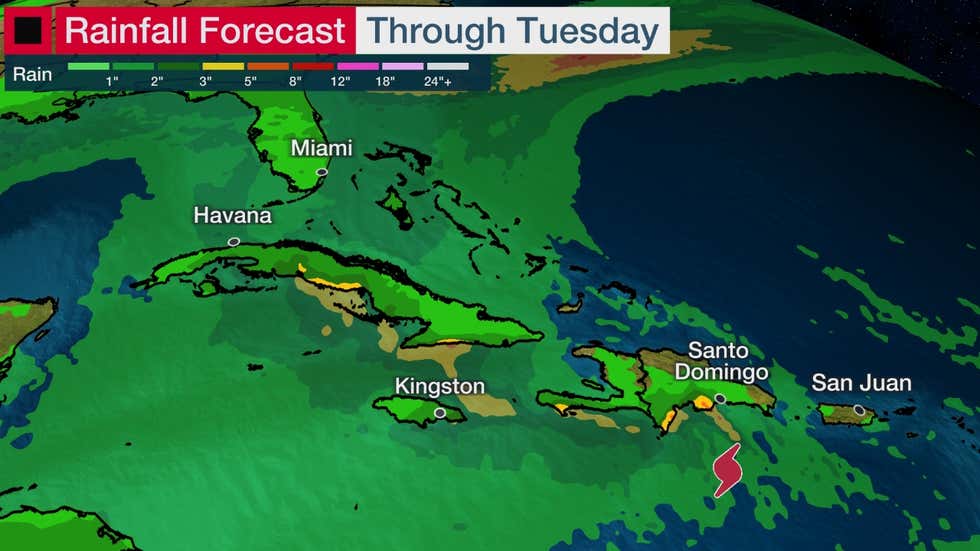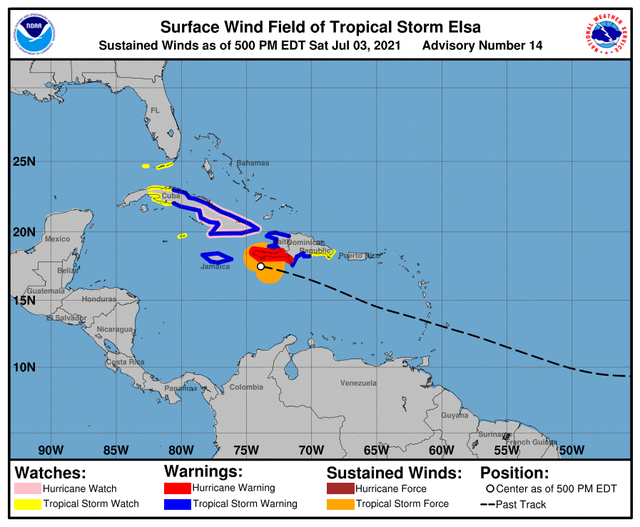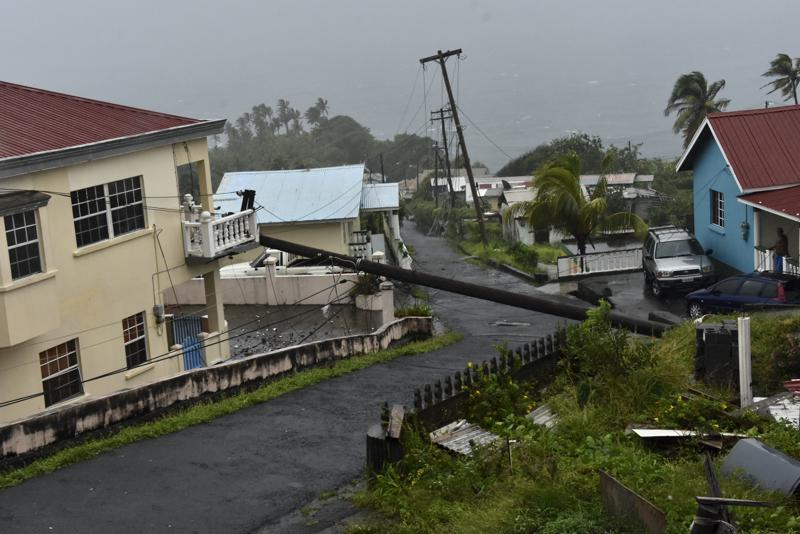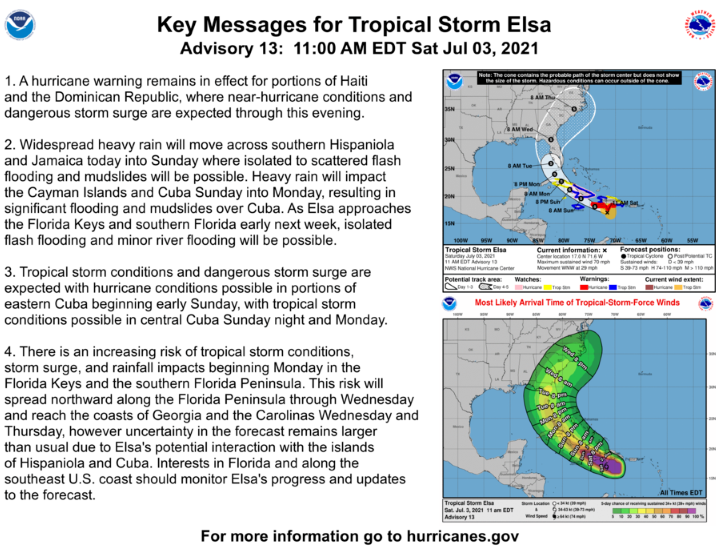CHRISTIANSTED — People in the U.S. Virgin Islands hoping that Hurricane Elsa would get close enough to the territory to effect heavy rainfall without the complimentary damaging winds — were disappointed to wake up and find that their cisterns hadn’t gotten a drop of new precipitation.
Elsa passed by the USVI without so much as a hello, but veteran storm watchers said any time a hurricane decides not to visit is a good eventuality.
The National Weather Service said Friday that Elsa’s outer band might interact with prevailing conditions and lead to as much as five inches of rain to the drought-stricken territory.
But according to NWS reporting at the Henry Rohlsen Airport in St. Croix, the big island itself recorded no discernable precipitation all day Friday or early Saturday morning.
After passing the USVI straight, Hurricane Elsa deflated to a tropical storm as it raced toward Haiti and the Dominican Republic on Saturday, but it still threatened to unleash flooding and landslides before taking aim at Cuba and Florida.
The storm was located about 40 miles (70 kilometers) south of Isla Beata, Dominican Republic and was moving west-northwest at 29 mph (46 kph). It had maximum sustained winds of 70 mph (110 kph) as the tropical storm, which had been a Category 1 hurricane earlier on Saturday, weakened during its approach to Hispaniola and Cuba according to the National Hurricane Center in Miami.
The long-term forecast track showed it heading toward Florida as a tropical storm by Tuesday morning, but some models would carry it into the Gulf or up the Atlantic Coast.
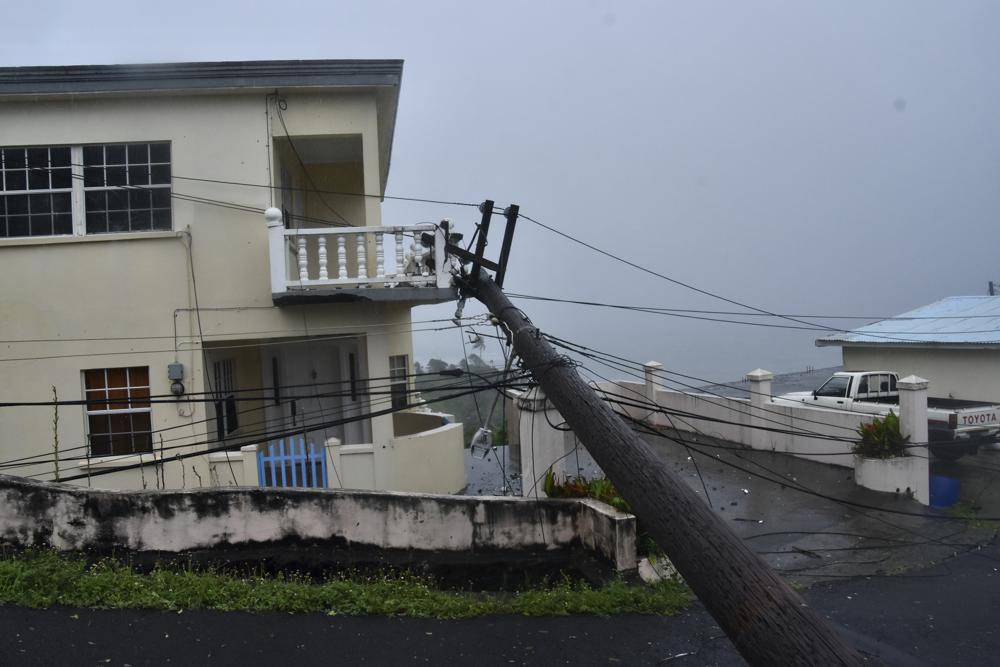
In Haiti, authorities used social media to alert people about the storm and urged them to evacuate if they lived near water or mountain flanks.
“The whole country is threatened,” the Civil Protection Agency said in a statement. “Make every effort to escape before it’s too late.”
Outer rainbands are affecting parts of Puerto Rico and Hispaniola, and tropical storm-force winds are nearing the southern coast of the Dominican Republic.
Haiti is especially vulnerable to floods and landslides because of widespread erosion and deforestation. In addition, a recent spike in gang violence has forced thousands of people to flee from their homes, so the civil protection agency is running low on basic items including food and water, director Jerry Chandler told The Associated Press.
“It’s been three weeks that we’ve been supporting families who are running away from gang violence,” he said. “We are working at renewing our stocks, but the biggest problem is logistics.”
He said officials are still trying to figure out how to deliver supplies to Haiti’s southern region, which is bracing for Elsa’s impact.
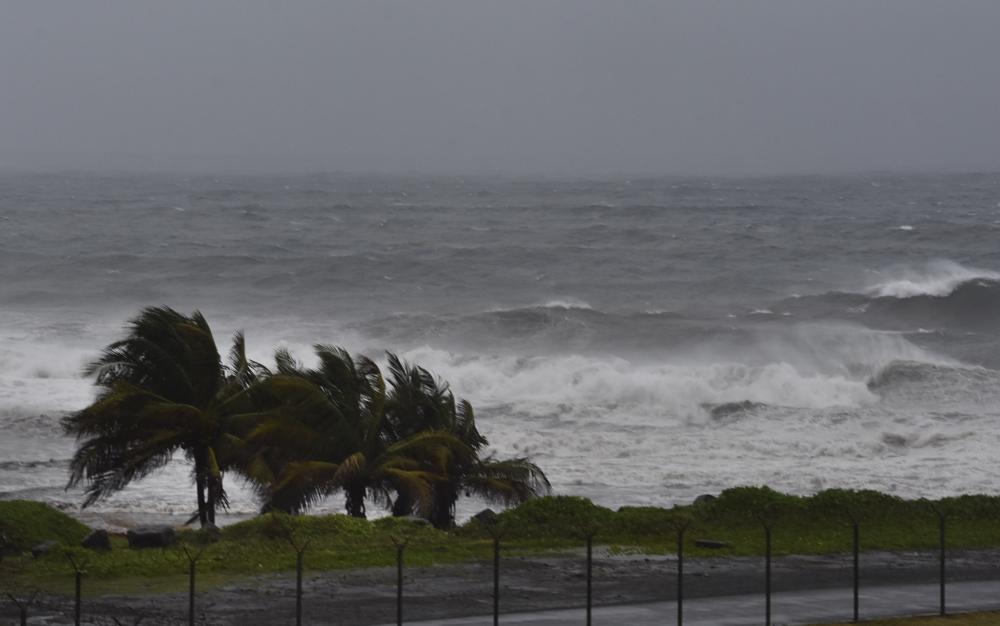
Meanwhile, people were buying water and food as the storm approached.
“I’m protecting myself the best that I can. Civil protection is not going to do that for me,” said Darlene Jean-Pierre, 35, as she bought six jugs of water along with vegetables and fruit. “I have other worries about the street … I have to worry about gangs fighting. In addition to this, we have a hurricane. I don’t know what kind of catastrophe this is going to cause.”
A hurricane warning remains in effect from the Haitian capital of Port-au-Prince to Punta Palenque in the Dominican Republic. A hurricane watch was issued for the Cuban provinces of Camaguey, Granma, Guantanamo, Holguin, Las Tunas, and Santiago de Cuba. Some of those provinces have reported a high number of COVID-19 infections, raising concerns that the storm could force large groups of people to seek shelter together.
“Anticipating is the key word,” said Cuban President Miguel Díaz-Canel, adding that vaccination efforts would continue. “Let’s take care of lives and property.”
In the neighboring Dominican Republic, which shares the island of Hispaniola with Haiti, authorities opened more than 2,400 shelters as forecasters warned of heavy rains. Officials also ordered evacuations ahead of the storm as people kept stocking up on supplies.
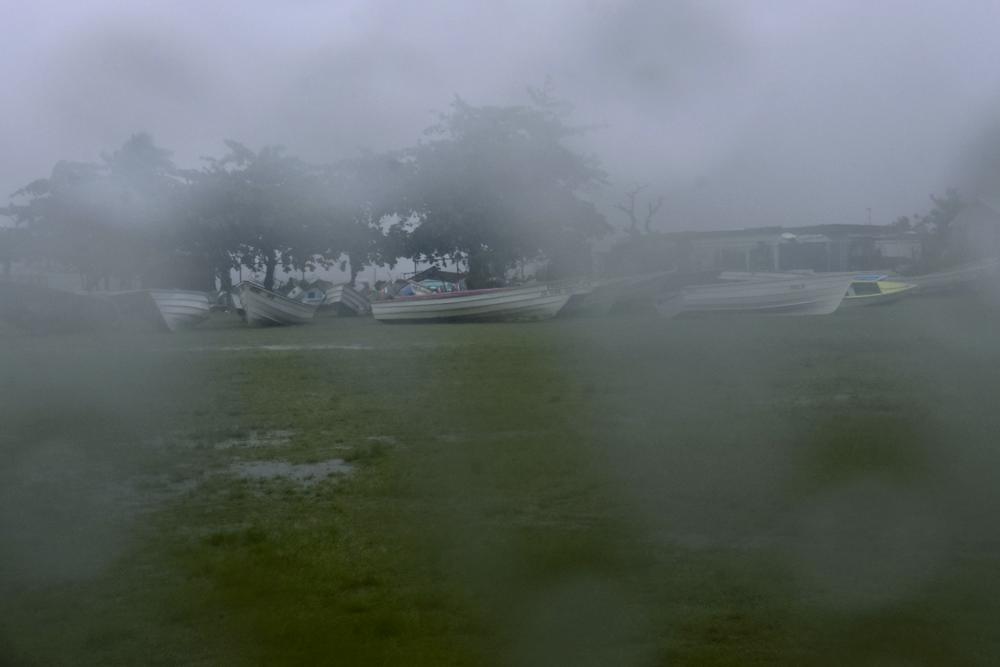
Some people worried about the state of their homes, with many living under corrugated roofing.
“I have a lot of leaks in my zinc,” said María Ramos. “What are we going to do? Only God knows.”
Elsa was forecast to brush past the southernmost point of Hispaniola by Saturday afternoon and then take aim at communities in southern Haiti.
The storm already had ripped off roofs, destroyed crops and downed trees and power lines in the eastern Caribbean on Friday, with damage reported in Barbados, St. Lucia and in St. Vincent and the Grenadines, which also suffered massive volcanic eruptions that began in April.
At least 43 homes and three police stations were damaged, said St. Vincent Prime Minister Ralph Gonsalves.
“We expect that this number will increase as reports keep coming in,” he said. “We have some damage, but it could have been far worse.”
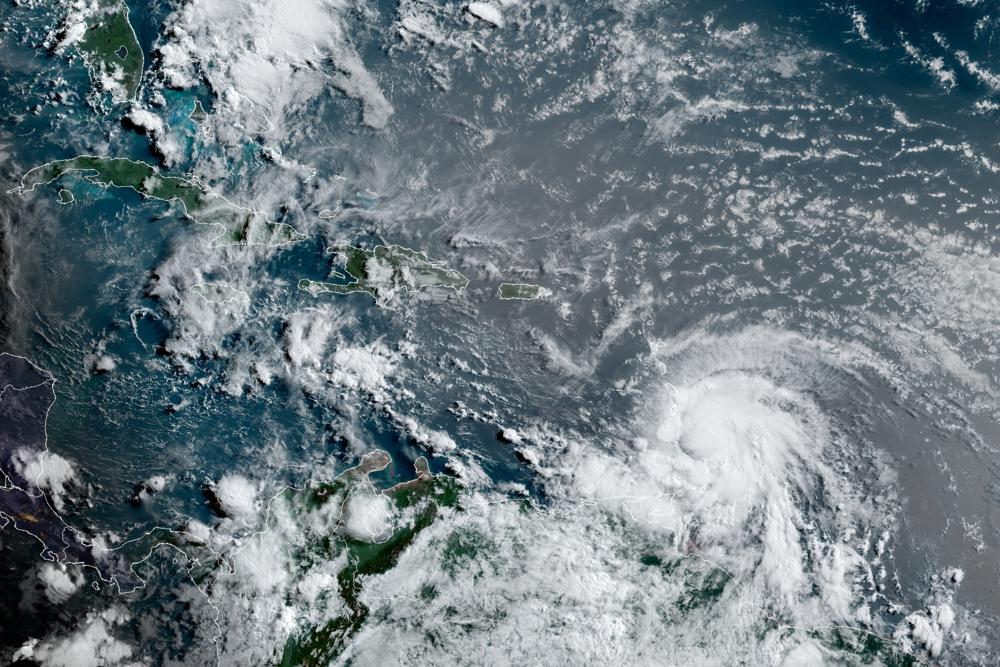
In St. Lucia, the wind damaged a secondary school, pummeling desks, overturning chairs and sending papers flying after blowing off the roof and siding.
Meanwhile, authorities in Puerto Rico rescued eight people, including two children, in stormy conditions after their boat sank amid 8- to 10-foot (2- to 3-meter) waves.
Elsa was the first hurricane of the Atlantic season and the earliest fifth-named storm on record. It is forecast to drop 4 to 8 inches (10 to 20 centimeters) of rain with maximum totals of 15 inches (38 centimeters) across portions of southern Hispaniola and Jamaica.
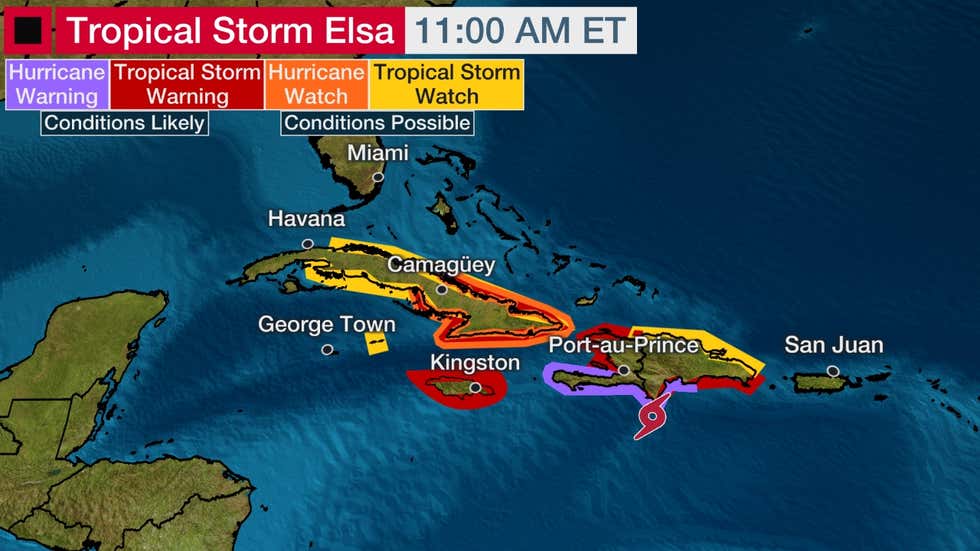
Current Alerts
Hurricane warnings are in effect for southern Haiti from Port-au-Prince south and the Dominican Republic from Punta Palenque westward where hurricane conditions are expected later Saturday.
A hurricane warning is also in effect in Jamaica, meaning hurricane conditions are expected by Sunday for the island.
A hurricane watch is in effect for portions of eastern and southern Cuba, meaning hurricane conditions are possible on Sunday.
A tropical storm warning has also been issued for the rest of the southern coast of the Dominican Republic and portions of northern Haiti where tropical storm conditions are expected later today.
A tropical storm watch has been issued for Cayman Brac and Little Cayman, but not for Grand Cayman.
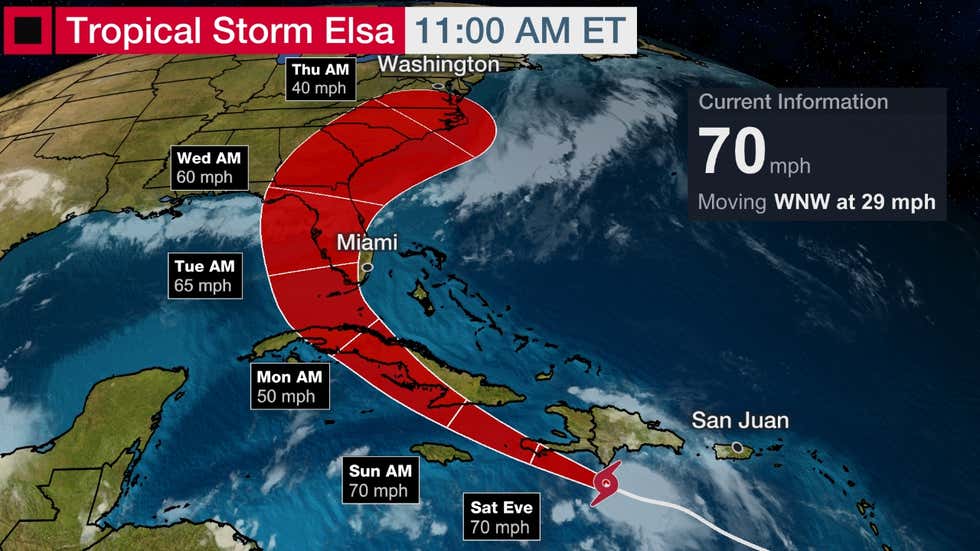
Forecast Details
Elsa will continue to move west-northwestward along the southern periphery of the Bermuda High through this weekend.
By Saturday night, that will put the center very near southwest Haiti’s Tiburon Peninsula.
A storm surge will raise water levels by as much as 2 to 4 feet above normal tide levels in areas of onshore winds along the southern coast of Hispaniola.
Up to 15 inches of rain could fall in southern portions of Haiti and the Dominican Republic, with much of the southern portions of the country picking up 4 to 8 inches. This could lead to flash flooding and mudslides. That said, the system’s fast forward speed will limit the heavy rain threat that might otherwise be greater.
Elsa will then sweep through Jamaica tomorrow, then Cuba Sunday into Monday.
Up to 15 inches of rain could fall in Jamaica, with much of the southern portions of the country picking up four to eight inches. A storm surge of up to three feet is possible in Jamaica.
